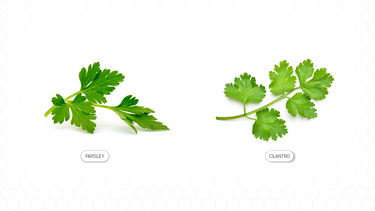Parsley vs. Cilantro: A Comprehensive Guide

Herbs add a burst of fresh flavor and welcome color to food, and parsley and cilantro are two of the most commonly used in cooking. Known as coriander outside the United States, cilantro tastes like soap to some people because it naturally contains a kind of chemical compound called aldehydes, which are actually used in soap making. Mixing the two herbs is surprisingly easy to do at the store, causing minor frustration for most, and worse for those who hate cilantro. A few simple tips will make it easy to tell these related herbs apart.
Parsley and cilantro are from the same family
Both parsley and cilantro belong to the Apiaceae family, also known as Umbelliferae. In fact, you can refer to the plants that are part of this family—which include celery, carrot, fennel, cumin, dill, caraway, and parsnip—as umbellifers. Pretty cute! Parsley is rich in vitamins C and K, but both herbs are packed with vitamin A. Though you can find both dried parsley and cilantro in the spice aisle at the grocery store, the fresh stuff will give you a much better result.
Here’s how to tell parsley and cilantro apart:
- By sight: Of course, the problem is that these herbs look so alike, but there are subtle differences to help you tell them apart. Both herbs have branching leaves with pointed tips, however cilantros are slightly more rounded. Flat-leaf parsley has pointier tips and a hardier appearance. Curly parsley is easier to tell apart from both since its leaves are—as the name implies—curled.
- By smell: Cilantro has a spicy, citrusy aroma that is stronger than parsley, which has a mild, herbal scent similar to grass. Of course, depending on how fresh the herbs are, they might not have much of a smell at all.
How to store, wash, and chop parsley and cilantro
When you buy a bunch of parsley or cilantro, place them in a glass of water and stand them in the fridge, or wrap them in a damp paper towel and place in a plastic bag. Cilantro will last up to a week, while parsley will last up to two. When ready to use either herb, pick the leaves from the stems and wash them in a salad spinner (or a dedicated herb spinner, if you have one). You can also fill a bowl with water and swish the leaves around to release any dirt. Then, use your fingers to pull the leaves out and transfer them to a clean dish towel. Dry the leaves fully by gently patting them on a flat surface with a clean dish cloth, then transfer them to a dry cutting board. A sharp chef's knife is best for cutting herbs, which allow you to rock back and forth over the pile to get a fine, confetti-like texture.
How to use cilantro
While both cilantro and parsley are versatile ingredients in the kitchen—from everything soups and stews to salads to salad dressings—their differing flavors mean they’re best in different dishes. Though there are no hard and fast rules for its use, cilantro is particularly popular in Latin American, Caribbean, and Asian cuisines. Use cilantro in salsa, curries, and stir fries, as a topping for tacos, a sauce for grilled fish, or mixed with yogurt for an easy dip. Cilantro stems are often tender enough to finely chop and use with the herbs. While some people think cilantro tastes like soap (thanks to those pesky aldehyde compounds), others are absolutely crazy for the flavor. If you’re in the latter camp, double down on the flavor by adding ground coriander seeds to your dishes, which come from the same plant as cilantro.
How to use parsley
Parsley is popular all over the world. A shower of parsley adds color and bright flavor to saffron rice, seafood pasta, and a classic rolled French omelet. You’ll find Parsley stirred into Greek salad, stirred into chimichurri, forming the base of tabbouleh, chopped into a lemony gremolata sauce, and folded into kuku sabzi (a Persian herb frittata). Thanks to their sturdy leaves, parsley tends to last a while in the fridge. Though parsley stems aren’t as tender as cilantro, they’re ideal for saving and adding to homemade stock.





